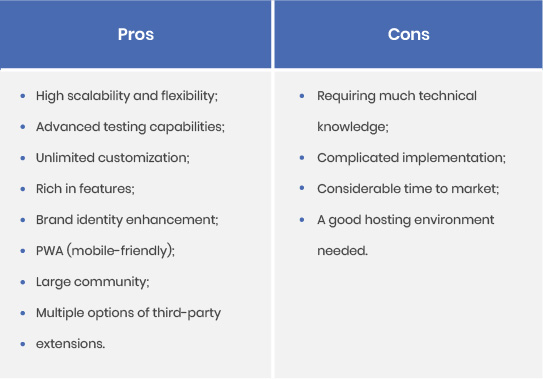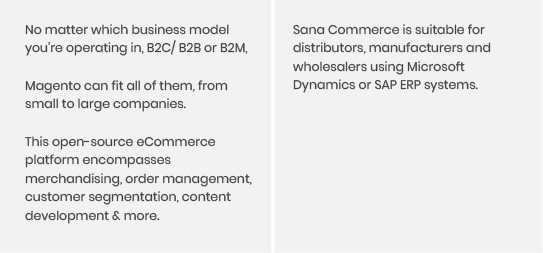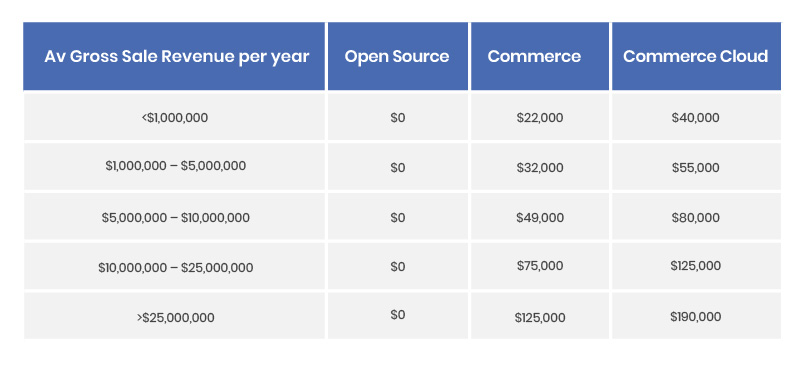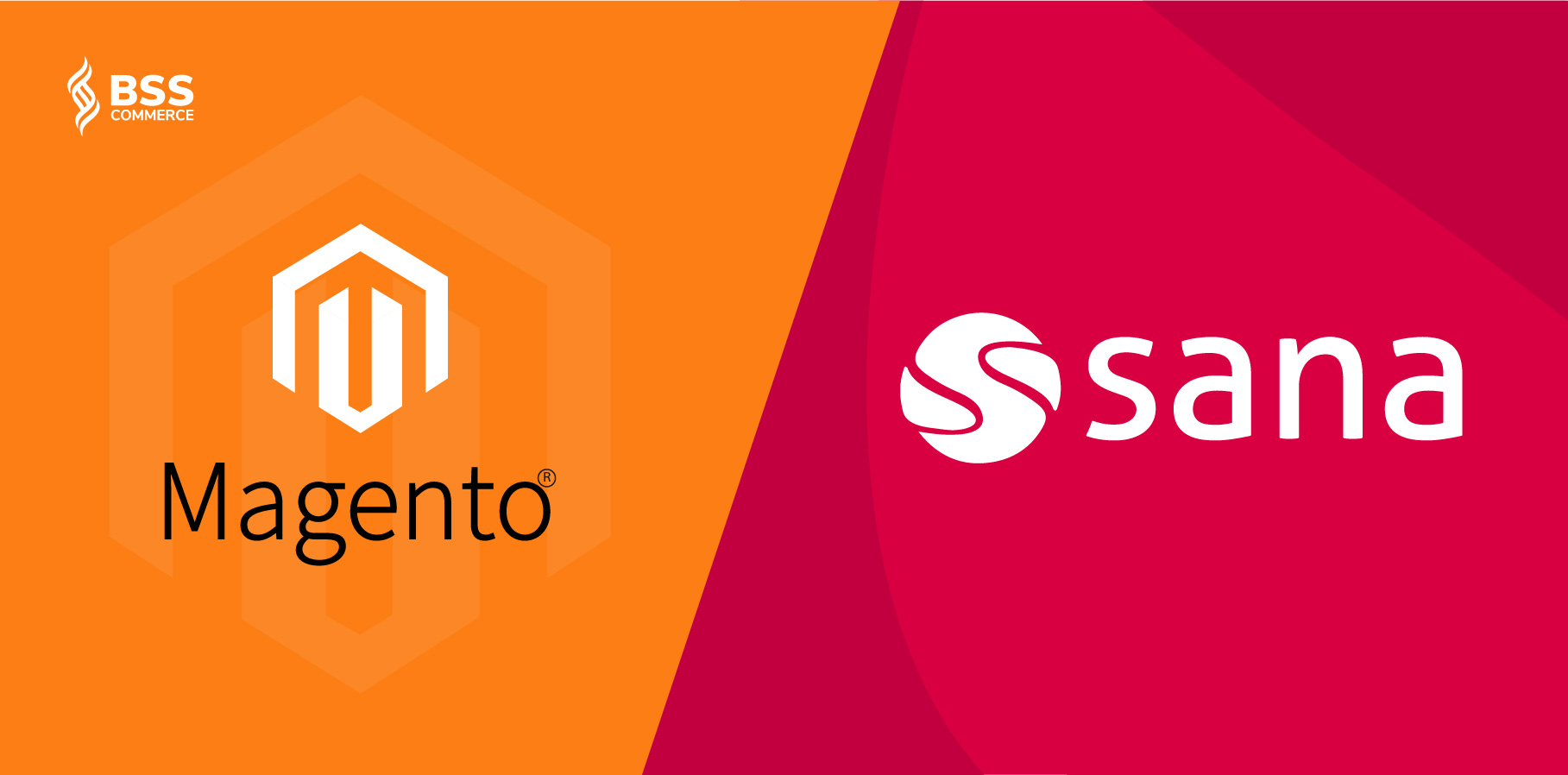Are you a merchant planning to move online? Do you provide your products/services to multiple customer groups, including both B2B and B2C? Are you seeking a B2B eCommerce platform to build a B2B/ B2M website on and meet your business demands? Then you’re landing at the right place! We’ll compare Sana Commerce vs Magento – the two popular names in the B2B eCommerce community.
For a clearer view, this post weighs up Magento vs Sana Commerce through major standards: target users, B2B features, pricing, and others.
Check other articles in our comparison series:
- Magento vs Oracle Commerce
- Magento vs Salesforce Commerce Cloud
- Magento vs Shopify
- Magento vs Oro Commerce
Glide down to see the battle of an ERP-integrated platform vs a digital market leader – who will win?
Sana Commerce vs Magento Overview
Table of Contents
In general, Sana Commerce and Magento are both eCommerce platform providers who strike different target audiences. While Sana Commerce focuses on building the image of an ERP-integrated e-commerce platform for small wholesalers, distributors, and manufacturers, Magento has long been known as a leader in the eCommerce world, widely adopted by medium-to-large B2C & B2B businesses.
Most merchants scouring for an ultimate eCommerce solution for their online B2B website will run into Magento, sooner or later. Although the two were born nearly at the same time, Magento has quickly gained its popularity and reached the leading position with over 150k live sites (both free and paid). Meanwhile, Sana Commerce still functions mainly on its ERP integration solution.
READ MORE: A Complete Introduction To ERP And ERP For Magento 2!
Magento

Magento is an open-source eCommerce platform written in PHP. It was acquired by Adobe Inc in May 2018 for $1.68 billion USD. For over a decade of development, Magento has equipped worldwide merchants with a practical and robust method, shortening their journey to become a major leaguer in the online community.
It’s no coincidence that this platform always ranks high in all the comparison charts from any reputable analytics reports.
Building an ecosystem of 150k+ developers and 300+ professional solution providers, Magento, undisputedly, tops the “billboard” regarding efficiency, agility and adaptability, and reasonable total cost of ownership. Not only that, but you can savor a fundamental set of enterprise processes that embraces every business demands to manage key accounts and multiple brands.
Magento offers 3 editions, among which is one free license and 2 charged ones: Magento Open Source (Magento 2 Community), Magento Commerce (Magento 2 Enterprise), Magento Commerce Cloud.
Among them, Magento Commerce Cloud is a premium edition with crucial features to build an eCommerce website.

Sana Commerce

ERP integration is the foundation of Sana Commerce. The team aims to deliver a top platform that leverages the ERP as its major source of information. Frankly, it’s quite unconventional to approach the eCommerce environment this way.
Normally, other platforms build a site from the scratch, operating as a standalone subject without ERP integration at first. Sana Commerce ensures to directly integrate the ERP without third-party intervention.

Criteria to Compare Sana Commerce vs Magento
Target Users

Magento vs Sana Commerce: B2B features
We bring up B2B features as a comparison criterion of Sana Commerce vs Magento because both are famous for B2B capabilities. Before seeing how merchants can benefit from these platforms, let’s take a quick look at the following core feature table to grab their specializations:

Now, it’s time to dig deeper into the B2B features of each platform provider!
Magento 2 B2B features
The free edition – Magento Open Source – doesn’t offer B2B functionality by default. However, it’s quite simple and economical to integrate Magento 2 B2B extensions from trustworthy providers into your website.
As mentioned above, there are tons of B2B solution suppliers on the market to choose a high-quality module set at a competitive price point. The fact has shown that Magento Open Source sites, equipped with must-have B2B extensions Magento 2, operate as effectively as Magento Commerce/ Commerce Cloud ones.
Seeking an elite solution to your B2B eCommerce business? JUMP INTO Magento 2 B2B Module INSTANTLY to savor industry-leading tools.
For those using paid editions, you can savor included B2B features without paying additional fees. In case you generate advanced business needs for industry particulars, don’t hesitate to refer to our exclusive B2B for EE Package, which includes 5 B2B extensions that aren’t included in Magento Commerce default.
Magento supports all types of business models, including B2C, B2B, B2M; so, the platform includes full abilities to bring your business closer to corporate customers, ranging from the first access to the post-purchase stage. This lives up to the personalization demands of B2B customers, foregrounds professionalism, streamlines the way sellers and buyers do transactions online, and skyrockets sales volume.
Key B2B features in Magento:
1. Access restriction
- Restrict access to some categories/ CMS pages/ product pages from specific customer groups.
2. Market segmentation
- Create a unique and informative B2B registration form to verify customer identity for better sales & marketing strategies.
3. Corporation management
- Grant each company a shared account for multi-users with different roles and permissions;
- Ensure higher conversion rates by assigning dedicated sales reps to particular customers.
4. Pricing personalization
- Hide prices of some products from individual customer groups;
- Tailor different price points to different customers with custom pricing feature;
- Optimize online request-for-quote flow to streamline the negotiation process.
5. Quick ordering process
- Search products and place orders all under one single quick order form to shorten the checkout time;
- Configure minimum order amount to improve your bottom line;
- Leverage requisition lists for interval purchasing plans;
- Support repeated transactions.
7. Shipping & payment optimization
- Apply certain shipping and payment methods to specific customer groups and regions;
- Enable corporate customers to use purchase orders (PO) as a payment method at the checkout to raise convenience.
8. Customer retention
- Refund store credits right into customer accounts to encourage them to return and continue doing business.
DOWNLOAD this Magento B2B Starter Guide for essential knowledge to build your own B2B online business!
Sana Commerce B2B features
This platform specializes in the B2B eCommerce market. Unlike their B2C counterparts, B2B buyers often go through pricing negotiation steps to arrive at an agreement. Due to the complexity involved in B2B transactions, Sana Commerce integrates with ERP, so merchants can deliver a consistent buying experience.
- Remove duplicate data, and as a result, significantly reduce technical and operational costs.
- Convey accurate product and pricing data;
- Utilize ERP-integrated approach to track order fulfillment, and manage complex delivery structures;
- Provide a 24/7 self-service portal to allow customers to place orders even when there is no sales rep;
- Include D2C sales support; bulk ordering, mobile access;
- Present payment options;
- Manage promotions;
- Stimulate reordering.
DISCOVER B2B web development service by BSS Commerce that commits to delivering a high-quality and feature-rich B2B website.
Magento vs Sana Commerce Pricing
Actually, there are no fixed pricing plans for Sana Commerce users. To know exactly, merchants need to consult the team, and the price varies based on business requirements. Overall, Sana Commerce is made up of two parts, including a One-time setup fee and Monthly subscription fees (hosting & services). A drawback of this request-for-quote scheme is that you can’t figure out the basic total cost of ownership (TCO), which makes it hard to depict a spending plan for your business.
As opposed to Sana Commerce obscure pricing, Magento makes the TCO as clear as possible so merchants can calculate possible spending and have the best preparation for their online shift.

DON’T SKIP Magento B2B pricing to comprehend all cost implications and what you would have to spend when building a Magento 2 B2B site.
Where Magento Dominates The eCommerce World
Platform support
Sana Commerce has created their ERP eCommerce solutions for Microsoft Dynamics (Microsoft Dynamics AX, Microsoft Dynamics GP, Microsoft Dynamics NAV, Microsoft Dynamics 365 for Finance and Operations, Microsoft Dynamics 365 Business Central) and SAP (SAP ERP, SAP S/4 HANA, SAP Business One, SAP Business One HANA).
While Sana Commerce sticks to one field, Magento is cross-platform computer software. By developing a website on Magento, you will be able to expand your potentials to the largest scope.
A plethora of third-party providers
In terms of solution abundance, Magento has no rivals. This platform attracts tons of extension providers on the market at competitive price points. You can easily find a Magento extension, add-ons or an agency that can will your requirements into existence.
Scalability
Magento allows the construction and application of extensions to enhance the shopping experience. You can fully expand the features with Magento 2 modules to suit your specific business purposes. Meanwhile, this task is hard to be accomplished when you build your site on 3dcart.
Mobile experience
This platform utilizes HTML5 to enhance the UX on mobile devices. Magento-built websites cover all features related to customizable photo and video sizes and drag & drop functionality.
Multitasking capabilities
The industry-leading platform allows creating multiple online stores that can be managed on a single admin page.
Ability to support effective SEO
Last but not least, it offers various SEO-friendly features including URL Rewrite, Search URL, Layer Positioning, Sitemaps,…
Conclusion
To cut a long story short, when comparing Sana Commerce vs Magento, we see that the latter serves a wider range of customer segments than the former does, and they meet each other at the B2B fertile land.
You may wonder “What types of B2B e-commerce companies is SANA best suited for?”. Sana Commerce fits midmarket manufacturing or wholesale companies that run SAP or Microsoft Dynamics ERPs. Meanwhile, Magento provides a robust structure for both B2C and B2B eCommerce community to thrive in their companies, enhance brand awareness and reach more niches.
Anyways, the choice is yours. Let’s define your vision, budget and requirements to pick a suitable platform!
BSS Commerce is one of the leading Multi-platform eCommerce solutions and web development service providers in the world. With experienced and certified developers, we commit to bringing high-quality products and services to optimize your business effectively.
If you are planning to build a B2B website, leave us your information in the following form and we will contact you soon to give you the best consultation.
BSS Commerce is one of the leading Magento extension providers and web development services in the world. With experienced and certified Magento developers, we commit to bringing high-quality products and services to optimize your business effectively. Furthermore, we offer FREE Installation – FREE 1-year Support and FREE Lifetime Update for every Magento extension.
CONTACT NOW to let us know your problems. We are willing to support you every time.
